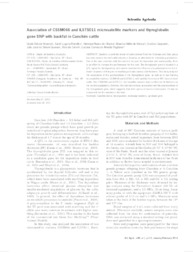Association of CSSM066 and ILSTS011 microsatellite markers and thyroglobulin gene SNP with backfat in Canchim cattle.
Association of CSSM066 and ILSTS011 microsatellite markers and thyroglobulin gene SNP with backfat in Canchim cattle.
Author(s): VENERONI, G. B.; MEIRELLES. S. L.; OLIVEIRA, H. N.; ALENCAR, M. M. de; GASPARIN, G.; GOUVEIA, J. J. de S.; CERVINI, M.; REGITANO, L. C. de A.
Summary: Canchim, a synthetic breed of cattle derived from the Charolais and Zebu group has been used in the beef-cattle industry in Brazil as an alternative for intensifying production. One of the main concerns with this breed is its poor fat deposition and consequently, there is an effort to increase the performance for this trait. The thyroglobulin gene is located in a QTL region for fat deposition, and reports describe the influence of a polymorphism in the 5' leader sequence of that gene on marbling and subcutaneous fat thickness. This study analyzed the association of this polymorphism in the thyroglobulin gene, as well as of two flanking microsatellite markers, CSSM066 and ILSTS011, with backfat thickness in 987 Canchim beef cattle. The CSSM066 and ILSTS011 microsatellite markers have a effect on fat thickness in the studied populations. However, this trait did not have association with the polymorphism of the thyroglobulin gene, which suggests that other genes of bovine chromosome 14 may be responsible for the variation in this trait.
Publication year: 2012
Types of publication: Journal article
Keywords: Canchim breed, Candidate gene, Fat deposition, Molecular markers
Observation
Some of Embrapa's publications are published as ePub files. To read them, use or download one of the following free software options to your computer or mobile device. Android: Google Play Books; IOS: iBooks; Windows and Linux: Calibre.
Access other publications
Access the Agricultural Research Database (BDPA) to consult Embrapa's full library collection and records.
Visit Embrapa Bookstore to purchase books and other publications sold by Embrapa.

